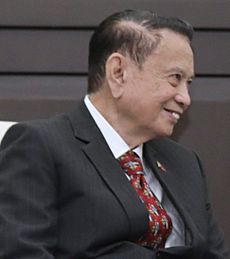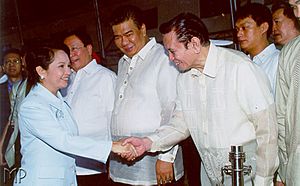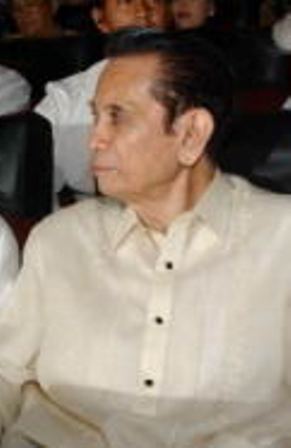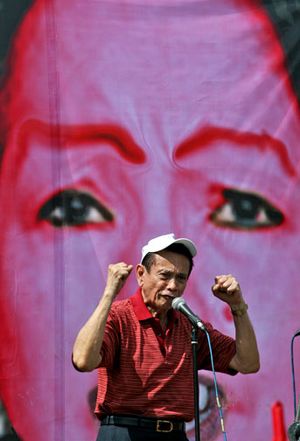Teofisto Guingona Jr. facts for kids
Quick facts for kids
Teofisto Guingona Jr.
|
|
|---|---|

Guingona in 2017
|
|
| 11th Vice President of the Philippines | |
| In office February 7, 2001 – June 30, 2004 |
|
| President | Gloria Macapagal Arroyo |
| Preceded by | Gloria Macapagal Arroyo |
| Succeeded by | Noli de Castro |
| Ambassador of the Philippines to China | |
| In office 2004 – July 8, 2005 |
|
| President | Gloria Macapagal Arroyo |
| Secretary of Foreign Affairs | |
| In office February 9, 2001 – July 2, 2002 |
|
| President | Gloria Macapagal Arroyo |
| Preceded by | Domingo Siazon Jr. |
| Succeeded by | Blas Ople |
| President pro tempore of the Senate of the Philippines | |
| In office January 18, 1993 – July 6, 1993 |
|
| Preceded by | Ernesto Maceda |
| Succeeded by | Leticia Ramos-Shahani |
| In office July 27, 1987 – July 23, 1990 |
|
| Preceded by | Senate re-established (Last held by Jose Roy) |
| Succeeded by | Sotero Laurel |
| Senate Majority Leader | |
| In office July 23, 1990 – July 22, 1991 |
|
| Preceded by | Orly Mercado |
| Succeeded by | Alberto Romulo |
| Senate Minority Leader | |
| In office July 27, 1998 – February 7, 2001 |
|
| Preceded by | Ernesto Maceda |
| Succeeded by | Aquilino Pimentel Jr. |
| Senator of the Philippines | |
| In office June 30, 1998 – February 7, 2001 |
|
| In office June 30, 1987 – July 6, 1993 |
|
| 48th Secretary of Justice | |
| In office May 20, 1995 – January 31, 1998 |
|
| President | Fidel V. Ramos |
| Preceded by | Demetrio Demetria |
| Succeeded by | Silvestre Bello III |
| Executive Secretary | |
| In office July 6, 1993 – May 19, 1995 |
|
| President | Fidel V. Ramos |
| Preceded by | Edelmiro Amante |
| Succeeded by | Ruben Torres |
| Chairman of the Commission on Audit | |
| In office March 10, 1986 – March 1987 |
|
| President | Corazon Aquino |
| Preceded by | Position established |
| Succeeded by | Eufemio Domingo |
| President of the Chamber of Commerce of the Philippine Islands | |
| In office 1968–1969 |
|
| Preceded by | Teofilo Reyes Jr. |
| Succeeded by | Rogelio Manalo |
| Personal details | |
| Born |
Teofisto Tayko Guingona
July 4, 1928 San Juan del Monte, Rizal, Philippines |
| Political party | Independent (2003–present) Lakas (1998–2003) LDP (1992–1998) Liberal (1987–1992) PDP–Laban (1983–1987) Laban (1978–1983) |
| Spouse | Ruth Saluper de Lara |
| Children | 3, including Teofisto III |
| Alma mater | Ateneo de Manila University (AB, LL.B) |
Teofisto "Tito" Tayko Guingona Jr. (born July 4, 1928) is a Filipino politician and diplomat. He served as the 11th Vice President of the Philippines from 2001 to 2004. This was during the first term of President Gloria Macapagal Arroyo. He was born in San Juan, which is now part of Metro Manila. He studied at Ateneo de Manila University while working.
Mr. Guingona was chosen to lead the Commission on Audit in 1986. This happened when Corazon C. Aquino became president. He then became a senator in 1987. While a senator, he also helped develop the Mindanao region. He was re-elected as senator in 1992. Later, he became the executive secretary and then the justice secretary. He was elected to the Senate again in 1998.
In 2001, Mr. Guingona became the Vice President of the Philippines. He was also the secretary of foreign affairs. This happened after President Joseph Estrada left office during the EDSA II event. This made Mr. Guingona the only Vice President not chosen by a national election. When his term ended in 2004, he did not run for a full term. Noli de Castro became the next Vice President.
Contents
Early Life and Education
Teofisto Guingona Jr. was born on July 4, 1928. His birthplace was San Juan del Monte, Rizal. Today, this area is known as San Juan, Metro Manila. His father, Teofisto Guingona Sr., was a former assemblyman and senator. His mother, Josefa Tayko, was from Siaton, Negros Oriental.
He grew up in the provinces of Agusan, Lanao, and Misamis Oriental. He finished his elementary school studies with honors at Ateneo de Cagayan. He continued his studies at the Ateneo de Manila University. There, he worked while studying law and economics. He also took special courses in Public Administration and Audit. After graduating, he worked in business. He became a governor of the Development Bank of the Philippines. He also led the Chamber of Commerce of the Philippine Islands.
Standing Up for What's Right
Mr. Guingona was part of the 1971 Constitutional Convention. This group worked on changing the country's laws. When Ferdinand Marcos declared martial law in 1972, Mr. Guingona spoke out against unfair actions. He worked as a lawyer to protect human rights.
He started groups like SANDATA and BANDILA. These groups worked for social and economic improvements. Because he opposed martial law, he was put in jail two times. This happened in 1972 and again in 1978. When President Marcos was removed from power in 1986, Corazon Aquino became president. She chose Mr. Guingona to lead the Commission on Audit. In this role, he became known for fighting against corruption.
Serving in the Senate
Mr. Guingona was first elected as a Senator in 1987. He was part of the Lakas ng Bayan group, which President Aquino supported. He became the Senate president pro tempore in 1987. He also served as the majority leader in 1990. During this time, he also helped lead the Mindanao Development Authority.
In 1992, Mr. Guingona ran for re-election and won. In 1993, he again became the majority floor leader. However, his time in the Senate ended early. President Fidel V. Ramos appointed him to a new role that same year.
Important Roles in Government
In 1993, President Fidel V. Ramos chose Mr. Guingona to be the executive secretary. This is a very important role in the president's office. In 1995, Mr. Guingona was appointed as the justice secretary.
As justice secretary, he improved programs that protect witnesses. He also started the Prosecution Academy. He helped put into practice the Katarungang Pambarangay, which is a local justice system. He also led the Presidential Anti-Crime Commission at the same time.
Becoming Vice President

In 1998, Mr. Guingona was elected back to the Senate. He became the minority floor leader. He was one of the first to ask President Joseph Estrada to step down. This was because of problems in the government. On January 17, 2001, he was among the senators who voted to open an envelope. This envelope supposedly had information about President Estrada. The vote was very close, 11-10, to keep it closed. This decision made people even more upset and led to the second uprising on EDSA.
After President Estrada was removed from office, Gloria Macapagal Arroyo became president. She chose Mr. Guingona to be her Vice President. He was confirmed by Congress on February 7, 2001. This made him the only Vice President who was not elected by the people. He was also the oldest person to hold the position, at 72 years old. He also served as the secretary of foreign affairs at the same time.
During his time as Vice President, he sometimes disagreed with President Arroyo. Especially about foreign policy. He resigned as secretary of foreign affairs on July 2, 2002. He also left his political party on October 3, 2003. In the 2004 Philippine elections, Mr. Guingona did not run for a full term. Noli de Castro became the next Vice President.
Life After the Vice Presidency
After his time as Vice President, Mr. Guingona accepted a role as ambassador to China in 2004. He later resigned from this position. He joined the opposition again during a political issue called the Hello Garci scandal. This controversy involved questions about the 2004 presidential election results.
On November 29, 2007, Mr. Guingona took part in a protest called the Manila Peninsula rebellion. This protest called for President Arroyo to resign. He was arrested after the event. However, on December 13, 2007, a court dismissed the rebellion cases against him.
Mr. Guingona wrote a book about his life called Fight for the Filipino. It was launched on July 4, 2008, which was his 80th birthday.
Family Life
Mr. Guingona is married to Ruth de Lara. She used to be a mayor and vice mayor in Gingoog, Misamis Oriental. His son, Teofisto III, also served as a senator. His daughter, Stella Marie, was also a mayor of Gingoog until 2019.



